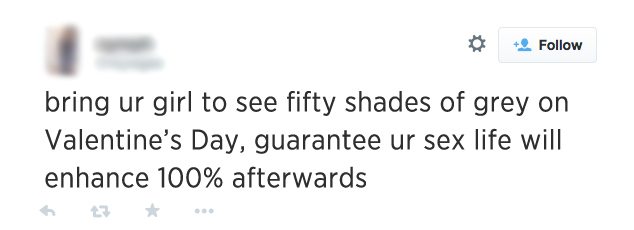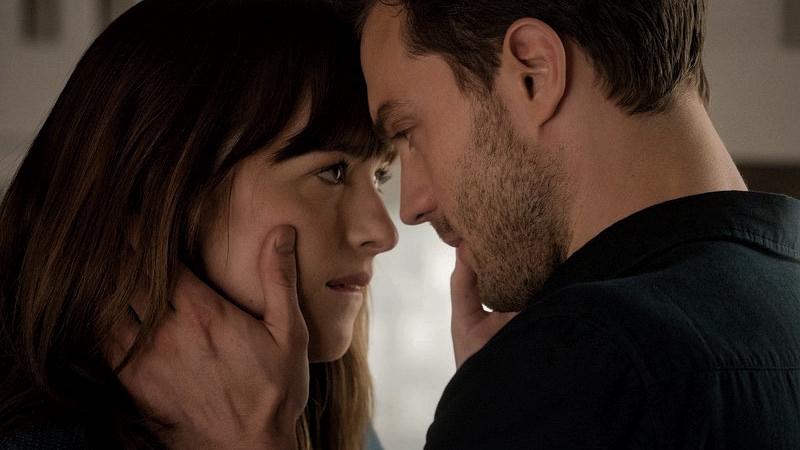Cover photo credit to Focus Features and Universal Pictures.
It’s your typical “boy meets girl” story, only it’s not. In case you haven’t heard, the final film from the “Fifty Shades” trilogy is out now, and it’s just a terrible ending to a toxic story.
To catch you up, “Fifty Shades Freed” continues the story’s explicit storyline of a twisted, inaccurate version of a sexual bondage, domination, submission, and sadomasochism (BDSM) relationship between controlling businessman, Christian Grey, and inexperienced recent college grad, Anastasia Steele (“Ana,” for short). This dark and twisty trilogy ends with a “picture perfect” wedding followed by some kidnapping drama and a surprise pregnancy that makes Christian furious, but ends up being exciting for the happy couple. It all sounds nice, but the underlying messages are quite the opposite, and we’ll tell you why.
But first, let’s see what people are saying about this latest installment. There’s got to be some #MeToo connecting going on, right, considering that major plot points involve Christian’s controlling and abusive tendencies toward Ana?


No? But surely people see that Christian isn’t a role model of any kind, right?

Oh no. If you’re disappointed by the warm welcome “Freed” is getting, you’re not alone.
At this point, you might be asking, “But why do you care, FTND?” We care about dropping some knowledge on this film and movie franchise because it’s selling itself as an exciting love story, certain to inspire the hearts of many to believe in fairytales, true love, etc. And while every semi-romantic series advertises itself that way, there’s a special kind of toxicity to that message attached to this particular trilogy. We are a pro-love, pro-healthy sex, and anti-porn organization, which is why we’re invested in exposing this fake romantic saga because it violates all three of the platforms we’ve built this worldwide movement on.
In order to understand the harmful messages of the books, and now big-budget films, one must see the overall storyline for what it is. As a recap, or for those who aren’t familiar, the “Fifty Shades” story centers around a controlling and sadistic millionaire CEO with a tormented past who seduces a sweet, inexperienced college girl into his selfish world of painful bondage sex. E. L. James, the author, wrote the Fifty Shades trilogy very loosely based on bondage and discipline (B&D), dominance and submission (D&S), and sadism & masochism (S&M) practices, or BDSM for short. But not even those within the BDSM community accept Christian’s behavior as being okay or representative of what happens during “scenes,” or encounters between BDSMers. Instead of a sexual interest, they too call it abuse.
But for the moment, let’s take a deeper dive into the inner workings of this story:
“If you have a tormented past, it’s okay to take your anger out on others because of it.”
Christian Grey, as it turns out, was abused as a child which is why he “doesn’t do love” and instead only has the ability to treat women he’s attracted to (who look uncannily like his deceased abusive mom) like objects on which to inflict sexual punishment and anger. Yikes.
“Because when I think of romance, I think of a controlling psychopath with mommy issues,” said Toni Matthews in this Inquisitor article. (Same, Toni.)
But that’s the deal with both porn and this twisted “love” story—it excuses unacceptable and abusive behavior because of some tragic alternative background factor, and disguises it with explicit and exaggerated sex and “romance.” But we can see through the facade, and identify the behavior for what it really is: abuse, not niche sexual interests. And abuse is inexcusable, even with a heartbreaking backstory, because people need to be held accountable and responsible for the pain they inflict on others. Note that this reason why we don’t buy the “romantic” side of this explicit story is the same reason we fight to raise awareness on the harmful porn industry that inflicts pain and damage in society, but refuses to take responsibility for it.
“Wealth can excuse someone’s toxic or unacceptable behavior.”
Imagine this story without the private planes, lavish gifts, and stacks on stacks of wealth. Put yourself in a situation with a partner who tells you how to dress, what to eat, and what prescription birth control to take because they “own” your body. This person isolates you from friends, family, and anyone who can talk sense into you, and justifies this jealousy with possessiveness and claiming that they just want you to be “all theirs.” This partner monitors your computer, phone, watching and recording your every move to make sure you don’t “disobey” and warrant punishment. They threaten violent consequences for protesting or disagreeing.
“Does this still sound like a romantic life worth fantasizing about? Do you really think money and gifts will make the pain, doubt, and confusion go away? I should imagine not,” writes Matthews.
“If you stay with an abuser long enough, they’ll change.”
Perhaps one of the most toxic ideas from the final installment of “Fifty Shades” is that if you try and love someone “hard enough,” you can “fix” them and they can overcome their abusive tendencies with you by their side.
As author and speaker Dr. Gail Dines points out, “Battered women’s shelters and graveyards are full of women who had the misfortune to meet a Christian Grey.”
This story is ultimately domestic violence dressed up as erotica, and it reinforces the deadly idea that it’s up to the lover to change and soften the abuser. And because we’re champions of real, healthy love, we have to speak up about the utter destruction of this dangerous idea.
Take it from reviewer Rosie Waterland, who was so disturbed by what she saw on-screen that she left the theater on the verge of tears:
“Putting this kind of controlling, emotionally abusive relationship in the context of a sexy billionaire who just needs to be loved, makes it ridiculously easy to convince audiences the world over that this kind of behavior is okay.
He’s not some poor drunk with a mullet, hitting his wife for not doing the dishes. Christian is classy. Rich. Educated. He’s not what most women imagine an abuser to be, and his kind of abuse is not what most women would immediately recognise.”
As a joint project between nonprofits London Abused Women’s Centre, National Center on Sexual Exploitation, Culture Reframed and Collective Shout, if you’d like to support shelters where women like Ana end up in real life, definitely check out #50DollarsNot50Shades.
Fifty Shades of Abuse
In order to truly highlight the extremely negative and harmful ideals contained in “Fifty Shades” trilogy, we made a shareable list, with an accompanying infographic, of five more toxic “fantasies” sold in this story.
Read and share:

We think it goes without saying that we will be spending Valentine’s Day with our loved ones, not reading or watching disturbing, romanticized abuse. We are all about real love and real intimacy, and “Fifty Shades” is clearly the opposite of that.
What YOU Can Do
If you’re not cool with the twisted ideals and perceptions that material like “Fifty Shades” trilogy pushes into our society, SHARE this article. Add your voice to the conversation and spread the word that this is anything but a love story.
Spark Conversations
Just like the “Fifty Shades” franchise, pornography normalizes and romanticizes abuse. Porn ignores consent, promotes violence, encourages coercion, advertises objectification, and sells exploitation. Grab this conversation-starting tee and join us in fighting for real love and healthy relationships:
Your Support Matters Now More Than Ever
Most kids today are exposed to porn by the age of 12. By the time they’re teenagers, 75% of boys and 70% of girls have already viewed itRobb, M.B., & Mann, S. (2023). Teens and pornography. San Francisco, CA: Common Sense.Copy —often before they’ve had a single healthy conversation about it.
Even more concerning: over half of boys and nearly 40% of girls believe porn is a realistic depiction of sexMartellozzo, E., Monaghan, A., Adler, J. R., Davidson, J., Leyva, R., & Horvath, M. A. H. (2016). “I wasn’t sure it was normal to watch it”: A quantitative and qualitative examination of the impact of online pornography on the values, attitudes, beliefs and behaviours of children and young people. Middlesex University, NSPCC, & Office of the Children’s Commissioner.Copy . And among teens who have seen porn, more than 79% of teens use it to learn how to have sexRobb, M.B., & Mann, S. (2023). Teens and pornography. San Francisco, CA: Common Sense.Copy . That means millions of young people are getting sex ed from violent, degrading content, which becomes their baseline understanding of intimacy. Out of the most popular porn, 33%-88% of videos contain physical aggression and nonconsensual violence-related themesFritz, N., Malic, V., Paul, B., & Zhou, Y. (2020). A descriptive analysis of the types, targets, and relative frequency of aggression in mainstream pornography. Archives of Sexual Behavior, 49(8), 3041-3053. doi:10.1007/s10508-020-01773-0Copy Bridges et al., 2010, “Aggression and Sexual Behavior in Best-Selling Pornography Videos: A Content Analysis,” Violence Against Women.Copy .
From increasing rates of loneliness, depression, and self-doubt, to distorted views of sex, reduced relationship satisfaction, and riskier sexual behavior among teens, porn is impacting individuals, relationships, and society worldwideFight the New Drug. (2024, May). Get the Facts (Series of web articles). Fight the New Drug.Copy .
This is why Fight the New Drug exists—but we can’t do it without you.
Your donation directly fuels the creation of new educational resources, including our awareness-raising videos, podcasts, research-driven articles, engaging school presentations, and digital tools that reach youth where they are: online and in school. It equips individuals, parents, educators, and youth with trustworthy resources to start the conversation.
Will you join us? We’re grateful for whatever you can give—but a recurring donation makes the biggest difference. Every dollar directly supports our vital work, and every individual we reach decreases sexual exploitation. Let’s fight for real love:


